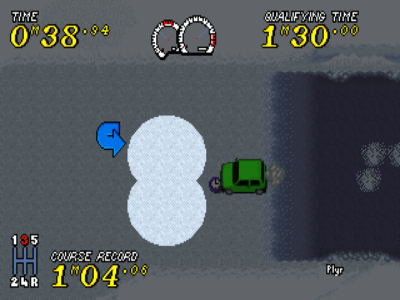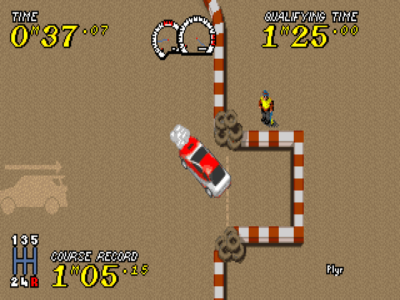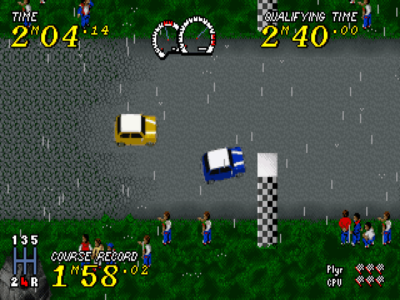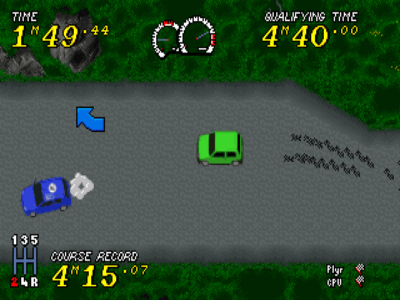
Power Drive
Written by: Rik
Date posted: May 20, 2012
- Genre: Racing
- Developed by: Rage
- Published by: U.S. Gold
- Year released: 1994
- Our score: 5
As we’ve said before, one of the great things about maintaining an interest in the oldies is that you get to play games that you always meant to try when they were released, but for whatever reason, never got around to it. Bizarrely, although I once owned a copy of Power Drive, I didn’t actually get to play it. This was back in the days when, due to the vagaries of running games in DOS, you’d arrive home from the shop half-expecting there to be some kind of problem installing and running the game – whether it was not enough EMS/XMS or conventional memory; or it didn’t like your graphics card or CD-ROM drive; or maybe the sound wouldn’t work – there’d always be something to spoil, or at least delay, your fun.
Anyway, Power Drive refused to run for some non-specific reason or other, and after several hours of uninformed and ultimately fruitless tinkering with settings, it was returned to the local PC World, who reluctantly agreed to an exchange despite experiencing none of the problems I described on their test machine. Exactly what I exchanged it for, I can’t quite remember, although I do recall the member of staff that I dealt with fixing me with a why’d-you-buy-this-in-the-first-place kind of look before attempting, unsuccessfully, to flog me a copy of the newly-released Wing Commander IV (although if I’d had an extra £40 at my disposal, and a machine more powerful than my 486, I’d have been tempted).
But now, thanks to the magic of abandonware and DOSBox, my 18-year long dreams of playing Power Drive have now finally been fulfilled. (Or, you know, a mild level of curiosity has been satisfied, however you like to put it.) If nothing else, it’s yet another rally game added to the FFG archives, although if I ever had any claim to a reputation as a genre connoisseur and racing ‘expert’, it would have been destroyed by the contents of this review, which will ultimately detail my failure to make significant progress here. (We’ll get onto that later, though).
In most respects, Power Drive contains few surprises, and the bulk of the game’s content could most likely be guessed by a moderately perceptive gamer upon glancing at a couple of screenshots. It’s a 2D arcade racer, viewed from an isometric angle, which provides the bulk of the challenge in that you can’t actually see where you’re going. To help, you’re given a visual warning of the severity and direction of the next corner, and a simple control scheme that consists of the basic forward/back, turn left/right deal and not a lot more.
The career mode is the only real option available. Practice is almost totally pointless, seeing as you can’t do so on anything except a large concrete square, and it serves no real purpose unless you’re not confident in being able to press the correct keys on your keyboard (in which case, you may as well give up, because this game’s not for you). In time-honoured fashion, you begin your career with a limited amount of money – just enough to buy a small car – and hope to earn more by qualifying for, or winning, a series of rally stages in various locations (and different conditions) around the world.

You need your lights in working order for night stages, if only so you can see the clocks and cash on the road.
Each rally location has a series of stages, which could either be a time-trial (qualify in a certain time), rally-cross (much the same, except you have the added distraction of an AI opponent), or a skill test (a bit like doing your driving test – stop in the box, reverse into a space, don’t hit any cones, etc etc). Of these, the first is the most palatable; the opponents during rally-cross get in the way, honk their horns and generally attempt piss you off in the most ungentlemanly manner possible, while the game engine doesn’t particularly lend itself to the more precise driving style required by the skill test. Besides, rallying is supposed to be a rather solitary pursuit, you against the clock, even if that doesn’t provide much variety or an awful lot in the way of visual excitement.
Still, it all sounds fair enough, and Power Drive certainly has all the ingredients for a decent arcade romp. In terms of looks and sounds, it’s all dated fairly well, and early races are quite enjoyable, requiring, as you’d expect, a certain amount of wrestling with the car, and a level of concentration to be maintained. At this stage, the difficulty seems pitched at the ‘tricky, but possible’ point. You’re able to qualify, it all appears quite do-able, and the presence of tiny cartoon clocks and piles of cash on the track (you can guess what happens if you drive over them) lends a certain cute harmlessness to proceedings.
But, let me tell you now, this is all just to lure you into a false sense of security. Power Drive doesn’t want you to succeed: you will fail. It’s not so much that the game itself is unfair – although the way the car skids does make you over-adjust unnecessarily, and at times you can get stuck on the scenery or at the side of the road, totally ruining your chances of qualifying – it’s more the way it’s structured. The main problem is with money, and how difficult it is to earn and keep enough to progress.
You have to pay to enter each stage, and also to repair your car at the end. How exactly you incur damage isn’t entirely clear, but it seems that you’ll have plenty to deal with no matter how carefully you drive. It soon becomes obvious that fully repairing everything after each stage is prohibitively expensive, but as you progress into more challenging conditions, the detriment to performance and handling that comes with a damaged car becomes too significant to manage. I thought I was making a decent fist of maintaining both my car and finances until roughly the halfway point of the game, at which point qualification was beyond my Fiat Cinquecento, regardless of what condition it was in.

Using a cheat code to unlock more powerful cars confirms that it only gets harder. Here, I’m fouling up a skill test.
Upon discovering the amount of cash required to buy the second-tier cars (according to a video on YouTube, not thanks to any information provided in-game – it’s in the region of $35,000-$38,000), I re-started with a Mini Cooper and took an ultra-conservative approach to paying for any repairs, but still ended up stuck at the same stage. I’m not saying it’s impossible, and it could certainly be the case that I’m just a bit shit, but having put quite a considerable amount of effort in, I had to admit defeat before I got anywhere near the end of the game. I should add, by the way, that even the progress I achieved involved cheating a little – saving the game after each successful stage, and re-loading again in case of failure instead of paying the entry fee again and having another go – but, you know, God help anyone who decides not to take all the help the game can give them, because it’s not much.
The more you look back at the old days, the more you come to conclude that modern gamers are whiney sissies, expecting to finish every new title they pay for, and in some respects Power Drive provides a refreshing counterpoint to more forgiving modern arcade racers. Even so, the difficulty level does seem to have been seriously misjudged. There’s a fun game to be made with these ingredients, but unless you possess remarkable powers of skill and persistence, Power Drive isn’t it.




 Posts
Posts